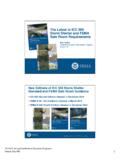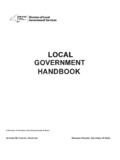Transcription of HEADQUARTERS Washington, DC, 1 October 1998
1 FM 21-20C1 HEADQUARTERSCHANGE 1 DEPARTMENT OF THE ARMYW ashington, DC, 1 october 1998 PHYSICAL FITNESS TRAINING1. Change FM 21-20, 30 September 1992, as follows: REMOVE OLD PAGESINSERT NEW PAGES14-3 to 14-814-3 to to 14-2214-21 to 14-222. A star (*) marks new or changed File this transmittal sheet in front of this RESTRICTION: proved for public release; distribution is 13 CHAPTER 14 APPENDIX ATABLE OF CONTENTS (CONT.)PAGEINJURIEST ypical Injuries Associated withPhysical Training ..13-1 Other Factors ..13-2 ARMY PHYSICAL FITNESS TESTM ethods of Evaluation ..14-1 Over-Forty Cardiovascular ScreeningProgram.
2 14-lOverview ..l4-2 Test Administration ..l4-2 Duties of Test Personnel..14-8 Test Site..i4-9 Test Procedures..l4-10 Test Sequence..l4-11 Test Results..l4-18 Scores Above Maximum..14-19 Temporary Profiles ..14-20 Permanent Profiles ..14-20 Alternate Events ..14-20 PHYSIOLOGICAL DIFFERENCESBETWEEN THE SEXES ..A-OAPPENDIX BAPPENDIX CAPPENDIX DAPPENDIX EAPPENDIX FAPPENDIX GAPPENDIX HPAGEPOSITIVE PROFILE FORM .. B-0 PHYSICAL FITNESS LOG .. C-ISTATIONARY BICYCLE TEST .. D-OSELECTING THE RIGHTRUNNING SHOE..E-1 CALCULATION OF V02 MAX .. F-1 PERCEIVED EXERTION..G-1 THE MAJOR SKELETAL MUSCLESOF THE HUMAN BODY.
3 H-OGLOSSARY .. Glossary-1 REFERENCES .. References-OINDEX..Index-OiiPrefaceOn 5 July 1950, troops, who were unpreparedfor the physical demands of war, were sent to battle. Theearly days of the Korean war were nothing short ofdisastrous, as soldiers were routed by a poorlyequipped, but well-trained, North Korean People s American soldiers withdrew, they left behindwounded comrades and valuable equipment theirtraining had not adequately prepared them to carryheavy costly lessons learned by Task Force Smith inKorea are as important today as ever. If we fail toprepare our soldiers for their physically demandingwartime tasks, we are guilty of paying lip service to theprinciple of Train as you fight.
4 Our physical trainingprograms must do more for our soldiers than just getthem ready for the semiannual Army Physical FitnessTest (APFT ).FM 21 -20 is directed at leaders who plan andconduct physical fitness training. It provides guidelinesfor developing programs which will improve and maintain physical fitness levels for all Army programs will help leaders prepare their soldiers to meet the physical demands of war. This manual canalso be used as a source book by all soldiers. FM 21-20 was written to conform to the principles outlined inFM 25-100, Training the benefits to be derived from a good physical fitness program are many.
5 It can reduce the number ofsoldiers on profile and sick call, invigorate training, and enhance productivity and mental alertness. A goodphysical fitness program also promotes team cohesion and combat survivability. It will improve soldiers combat proponent of this publication is HQ TRADOC. Send comments and recommendations on DA Form2028 (Recommended Changes to Publications and Blank Forms) directly to HEADQUARTERS , US Army InfantryCenter, US Army Physical Fitness School (ATZB-PF), Fort Benning, this publication states otherwise, masculine nouns and pronouns do not refer exclusively to soldier s level of physical fitness' has a direct impact on his combatreadiness.
6 The many battles in whichAmerican troops have fought under-score the important role physical fit-ness plays on the nationwide interest in fitnesshas been accompanied by many re-search studies on the effects of regularparticipation in sound physical fitnessprograms. The overwhelming conclu-sion is that such programs enhance aperson s quality of life, improve pro-ductivity, and bring about positivephysical and mental changes. Not onlyare physically fit soldiers essential tothe Army, they are also more likely tohave enjoyable, productive chapter provides an overviewof fitness.
7 It defines physical fitness,outlines the phases of fitness, anddiscusses various types of fitness pro-grams and fitness evaluation. Com-manders and leaders can use this infor-mation to develop intelligent, combat-related, physical fitness fitness, the emphasis ofthis manual, is but one component oftotal fitness. Some of the others areweight control, diet and nutrition,stress management, dental health, andspiritual and ethical fitness, as well asthe avoidance of hypertension, sub-stance abuse, and tobacco is primarily concerned withissues relating directly to the develop-ment and maintenance of the fivecomponents of physical Army s physical fitness train-ing program extends to all branches ofthe total includes theUSAR and ARNG and encompasses allages and ranks and both is to physically condition allsoldiers throughout their careers be-ginning with initial entry training (IET).
8 It also includes soldiers with limitingphysical profiles who must also par-ticipate in physical fitness and leaders must en-sure that all soldiers in their unitsmaintain the highest level of physicalfitness in accordance with this manualand with AR 350-15 which prescribespolicies, procedures, and responsibili-ties for the Army physical ResponsibilitiesComponents of physical fitness include weight control, diet, nutrition, stress management, and spiritual and ethical fitness. Effective leadership is critical tothe success of a good physical , especially seniorleaders, must understand and practicethe new Army doctrine of physical fit-ness.
9 They must be visible and activeparticipants in physical training pro-grams. In short, leaders must lead PT!Their example will emphasize theimportance of physical fitness trainingand will highlight it as a key elementof the unit s training must emphasize the valueof physical training and clearly ex-plain the objectives and benefits of Fitness Trainers(MFTs), graduates of a special coursetaught by the Army PhysicalFitness School, can help commandersdo this. However, regardless of thelevel of technical experience MFTshave, the sole responsibility for goodprograms rests with leaders at poorly designed and executedphysical fitness program hurts good program is well planned andorganized, has reasonable yet chal-lenging requirements, and is competi-tive and also hascommand presence at every level withleaders setting the example for should also continually as-sess their units to determine whichspecific components of fitness theylack.
10 Once they identify the short-comings, they should modify theirprograms to correct the should not punish soldierswho fail to perform to , especially excessive repe-titions or additional PT, often doesmore harm than good. Leaders must1-1plan special training to help soldierswho need it. The application of soundleadership techniques is especiallyimportant in bringing physically defi-cient soldiers up to standard. COMMAND FUNCTIONSC ommanders must evaluate the ef-fectiveness of physical fitness trainingand ensure that it is focused on theunit s missions.




